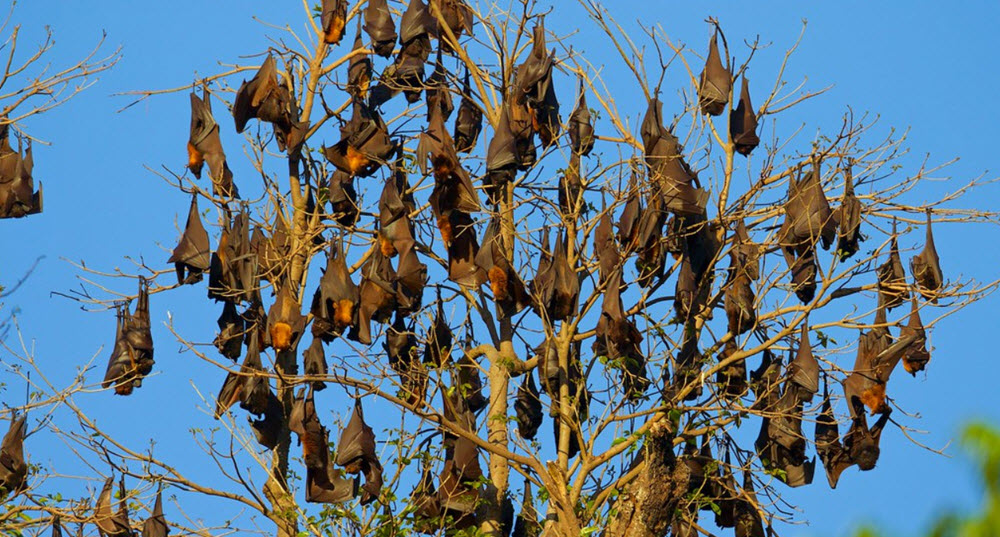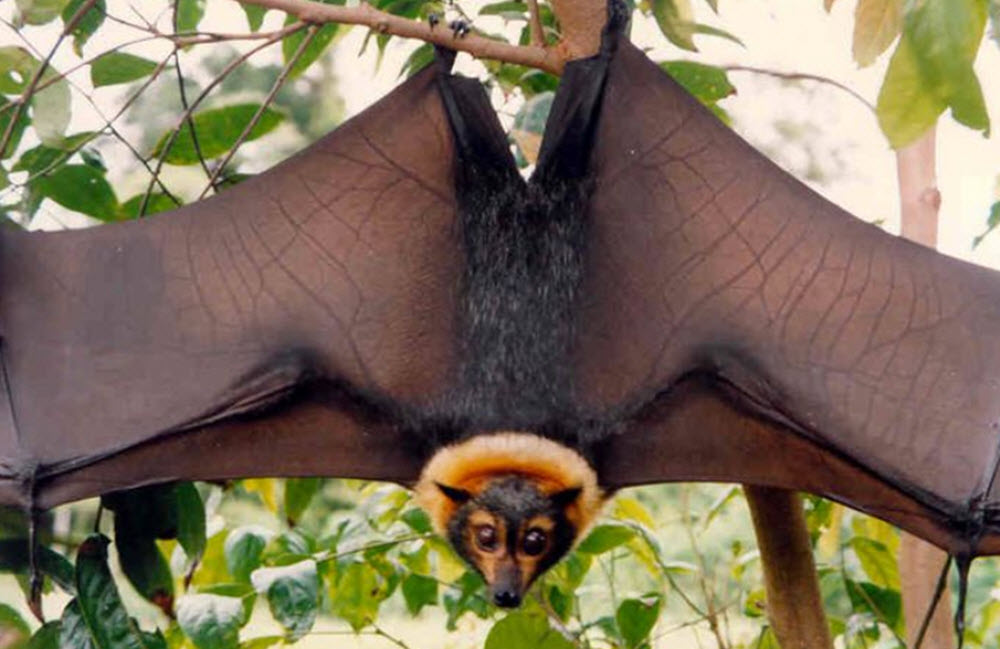Giant golden-crowned flying fox

With a wingspan of up to 1.7 meters, the Giant golden-crowned flying fox (Acerodon jubatus) is the largest bat in the world. It is also the second-heaviest, with a weight of up to 1.4 kg. Only the Great flying fox (Pteropus neohibernicus) weighs more, and not by a great margin.
The forearm of the Giant golden-crowned flying fox can meassure up to 215 mm, making it the longest forearm of any species – not just bats.
You don’t have to worry about this giant bat draining your blood, because it is a fruit bat. It’s alternative name is actually Golden-capped fruit bat and it is not aggressive towards human.
The Giant golden-crowned flying fox is endemic to the Philippines, where it lives in the forest. It doesn’t mind staying close to agricultural fields as long as there is a forest close by to shelter in. This bat is predominantly active at night and spends the days resting. It can fly 40 km or more in one night looking for food, and this mobility makes it an important seed disperser. The Giant golden-crowned flying fox is also a pollinator for several plant species.
Back in the days when fruit bats were still aboundant in the Philippines, the Golden-crowned flying fox would form huge colonies together with the Large flying fox (Pteropus vampyrus). According to some sources, up to 150,000 individuals could roost together in a single colony.
Contents
Scientific classification
| Kingdom: | Animalia |
| Phylum: | Chordata |
| Class: | Mammalia |
| Order: | Chiroptera |
| Family: | Pteropodidae |
| Genus: | Acerodon |
| Species: | Acerodon jubatus |
Subspecies
There are three subspecies:
- A. jubatus jubatus (Eschscholtz, 1831)
- A. jubatus lucifer (Elliot, 1896)
- A. jubatus mindanensis (K. Andersen, 1909)
Where does the Giant golden-crowned flying fox live?
Examples of Philippine islands that are still inhabited by the Giant golden-crowned flying fox are Luzon and Mindanao, as well as smaller ones such as Bohol, Boracay, Cebu, Leyte, Mindor, Negros, and Polillo.
The typical habitat for this bat is lowland forests below 1,100 meters. Nowadays, many of the bats rely on the trees that have survived along rivers to move through otherwise agricultural enviroments in search of food. Also, fig trees tend to grow near rivers, and these bats love eating figs.
What does it eat?
Figs and leaves are a very important part of the diet for the Giant golden-crowned flying fox.
A study carried out near Subic Bay on Luzon showed that compared to Pteropus vampyrus lanesis, A. jubatus is a more specialized feeder who tend to mainly eat fruits and leaves of the genus Ficus. They rarely venture into orchards to feed, and their staple food is leaves from hemi-epiphytic species of fig.
Grooming
Interestingly, this bat uses water to groom.

Reproduction
We still know very little about the reproductive habits of the Giant golden-crowned flying fox. There seems to be two breeding season per year, but with the females only getting pregnant during one of them. More researched is required to figure out what’s going on.
An A. jubatus female will become sexualy mature at the age of two.
Females usually give birth to just one pup per pregnancy.
Carrier of the Reston ebolavirus
The Reston ebolavirus is present in bats in the Philippines, including A. jubatus. Although so far, only bats in certain limited locations have been serologically tested, e.g. the Bulacan Province and the Subic Bay Freeport Zone.
The Reston ebolavirus can infect macaques but not humans. Philippine bats typically survive the infection.
Conservation status
The IUCN 3.1 lists the Giant golden-crowned flying fox as Endangered.
Human encroachment and destruction of forests is a main threat. In the year 1900, roughly 70% of the Philippines were covered in forests. Today, it is just around 20%. If we look at lowland forests only – the type of habitat where the Giant golden-crowned flying fox lives – only 10% of the original forest cover remains.
Another threat to the Giant golden-crowned flying fox is hunting, both for sport and for economical reasons. Both the meat and the pelts are desirable, and fruit bats are also sometimes regarded as pests since they eat fruit.